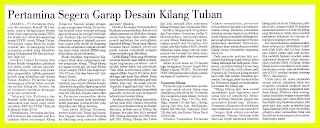Oil prices rebounded last weekend. However, oil prices are still vulnerable to decline, as oil supply continues to grow in flooding the market.
The price of West Texas Intermediate (WTI) oil rose 3.01% to US $ 48.51 per barrel Friday (18/8). Even so, this position is still lower 0.63% compared to the position of the previous week.
Nizar Hilmy, an analyst at Soe Gee Futures, said the decline in US oil stocks by 8.9 million barrels in the August 5-11 period could make oil prices rise.
However, not long after, the Energy Information Administration (EIA) announced rising US oil production. US oil stocks rose 79,000 barrels to 9.5 million barrels per day.
"Interesting pull of this sentiment that makes the gains slightly restrained," said Nizar, Friday (18/8).
Reseavch & Analyst Monex Investindo Futures Faisyal also assessed high US oil production data to be one of the catalysts that suppress oil prices.
"So overall, the price of oil is still depressed," said Faisyal.
Moreover, OPEC member countries are starting to ignore the deal on reducing oil production. Previously, OPEC will reduce production by 1.8 million barrels by the end of March 2018. BuIan then, OPEC members' compliance rate is still about 80%. Now down to 75%.
"If it is like this, the price of oil will be difficult to penetrate US $ 50 per barrel," Nizar added.
Still bearish
Although prices rose last weekend, Nizar sees oil still in a bearish trend. These energy commodities are still shrouded in negative sentiments. According to him, the abundant supply has the opportunity to press the price in the future. Crude oil production from several producing countries also showed an increase. In addition to the US, oil production in China and Libya also increased. The supply of crude oil at the port of Shandong Province, East China, rose 2.3% to 14.3 million barrels in the week ended Aug. 18.
Libyan production is stabilizing again after a strike in one of the mines can be overcome. Nizar predicts that by the end of the quarter, the price of oil can only move within the range of US $ 40-US $ 50 per barrel. By the end of the year, Faisyal predicts crude oil prices could continue to weaken to around US $ 40 per barrel.
"It will continue if OPEC does not make significant changes," he said.
Technically. Faisyai view, oil prices are below the moving average (MA) 50, MA 100, and MA 200. Medium, RSI and stochastic is at the level of 6.39 and 79.32. MACD is in the minus area of 0.314. Faisyal predicts, oil prices will weaken to the range of US $ 46.25 to US $ 48 per barrel. Then a week ahead the price will move between US $ 43.65-US $ 50 per barrel. Meanwhile, Nizar predicts oil price will move between US $ 46-US $ 48 per barrel and between US $ 45-US $ 49 per barrel in the next one week.
IN INDONESIA
Minyak Sulit Capai US$ 50 per Barel
Harga minyak kembali menguat akhir pekan lalu. Namun harga minyak masih rentan terkoreksi, karena pasokan minyak masih terus bertambah membanjiri pasar.
Harga minyak jenis West Texas Intermediate (WTI) naik 3,01% menjadi US$ 48,51 per barel Jumat (18/8) lalu. Meski begitu, posisi ini masih lebih rendah 0,63% dibandingkan posisi pekan sebelumnya.
Nizar Hilmy, analis Soe Gee Futures, mengatakan, penurunan stok minyak Amerika Serikat sekitar 8,9 juta barel di periode 5-11 Agustus sempat membuat harga minyak naik.
Tetapi, tidak lama kemudian, Energy Information Administration (EIA) mengumumkan produksi minyak AS naik. Stok minyak AS naik 79.000 barel meniadi 9,5 juta barel per hari.
“Tarik menarik sentimen inilah yang membuat penguatan sedikit tertahan," ujar Nizar, Jumat. (18/8).
Reseavch & Analyst Monex Investindo Futures Faisyal juga menilai data produksi minyak AS yang masih tinggi menjadi salah satu katalis yang menekan harga minyak.
“Jadi secara keseluruhan, harga minyak masih tertekan," ujar Faisyal.
Apalagi, negara anggota OPEC mulai mengabaikan kesepakatan pengurangan produksi minyak. Tadinya, OPEC akan mengurangi produksi sebesar 1,8 juta barel sampai akhir Maret 2018. BuIan lalu, tingkat kepatuhan anggota OPEC masih sekitar 80%. Kini turun jadi 75%.
“Jika seperti ini, harga minyak akan sulit menembus US$ 50 per barel,” imbuh Nizar.
Masih bearish
Meski harga naik akhir pekan lalu, Nizar melihat minyak masih dalam tren bearish. Komoditas energi ini masih diselimuti sentimen negatif. Menurutnya pasokan yang melimpah berpeluang menekan harga di kemudian hari. Produksi minyak mentah dari beberapa negara produsen juga menunjukkan kenaikan. Selain AS, produksi minyak China dan Libia juga meningkat. Persedian minyak mentah di pelabuhan Provinsi Shandong, China Timur, naik 2,3% jadi 14,3 juta barel di pekan yang berakhir 18 Agustus ini.
Sedang produksi Libia kembali stabil setelah pemogokan di salah satu tambang bisa diatasi. Nizar memprediksi di akhir kuartal Liga harga minyak hanya mampu bergerak dalam kisaran US$ 40-US$ 50 per barel.
Hingga akhir tahun, Faisyal memprediksi harga minyak mentah berpotensi melanjutkan pelemahan ke kisaran US$ 40 per barel.
"Ini akan terus berlanjut jika OPEC tidak melakukan perubahan yang signifikan," tandas dia.
Secara teknikal. Faisyai menilik, harga minyak berada di bawah moving average (MA) 50, MA 100, dan MA 200. Sedang, RSI dan stochastic ada di level 6,39 dan 79,32. MACD ada di area minus 0,314. Faisyal memprediksi, harga minyak akan melemah ke kisaran US$ 46,25-US$ 48 per barel. Lalu sepekan ke depan harga akan bergerak antara US$ 43,65-US$ 50 per barel. Sedang Nizar memprediksi harga minyak hari ini bergerak antar US$ 46-US$ 48 per barel dan antara US$ 45-US$ 49 per barel dalam kurun sepekan ke depan.
Kontan, Page-10, Monday, August 21, 2017









